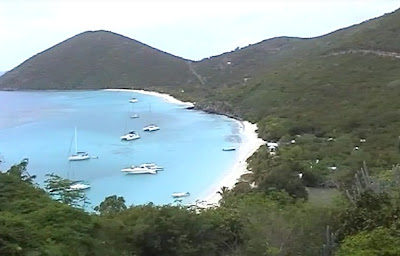4 May 2003
The Bahamas - where we sweltered, swam and drank a lot of rum.
At this point, we cruised for some weeks right on the inside edge of the infamous Bermuda Triangle - fortunately, we didn't disappear!
We stopped at Betsy Bay on Mayaguano Island and West Plana Cay for one night only and then moved to Rum Cay where we stopped for a few days.
Typical Bahamian sailboat
The anchorage at Rum Cay was rolly, it was still broilingly hot and we now had the added joy of mosquitoes. However, it was a friendly place and we met a few other cruisers. The water in the Bahamas is very shallow, with coral heads dotted all over the place, and therefore the most beautiful colour. The snorkelling was amazing so one day we went out spear fishing in the dinghy, hoping to snag a lobster. Fortunately, we caught nothing, as we later discovered it was not lobster season, and therefore illegal!
We spent one night at Concepcion Island (considered one of the most beautiful in the Bahamas) and reached Georgetown on 9 May, anchoring off Stocking Island. We did our check in here. We were moving further and further north and with the onset of summer in the northern hemisphere (! – Africa was never this hot!) the days were getting longer – it was still light at 7.45pm.
Had a 'hog roast' bbq up this creek near Georgetown
I managed to find an internet cafe here so could finally catch up on our mail – yay. This was a very crowded anchorage, though we were told it was less crowded than usual with a lot of boats having left the previous week. We heard that a lot of American boats sail down to the Bahamas and get no further than this anchorage because is very sociable and everyone has a good time – they hunker down waiting for a ‘weather window’ which is never quite wide enough for them. Beer is cheap, life is slow and easy, so they lose interest in the idea of sailing further down into more dangerous and ‘foreign’ waters.
Although it was nice here we didn’t linger as we wanted to get to Florida before the onset of the hurricane season (not that Florida is a safe haven, actually) so we moved on via Little Farmer’s Cay and Black Point to Highborne Cay. We went out one night for dinner with a bunch of yachties and I sat next to a man who told me about Zimbabwean sailors Liz and Pete Fordred. Paraplegics both, Pete and Liz had sailed their yacht across the Atlantic from Cape Town to Fort Lauderdale in the 80s and Liz had written a book about their incredible journey – An Ocean to Cross - you can find it on Amazon. My neighbour told me they had given a presentation at the Fort Lauderdale Sailing Club and he said it was the most amazing and moving presentation he had ever been to and they were given a standing ovation at the end. We didn’t know it then, but Pete and Liz would soon become good friends.
Two dolphins somehow got stuck in the harbour and entertained us for hours
We moved on to Nassau, a rather well developed town with high rise buildings, the most sophistication we had seen for some months, and we spent a number of steamy days there. Another reason to keep moving was that at least we got some lovely breeze blowing through the boat whilst sailing, and no bloody mosquitoes. Being at anchor on a breathless day could be very unpleasant.
Nassau Town
Coming in to Nassau Harbour
We also visited the extraordinarily ornate and pinkly plush Atlantis Casino Hotel – we particularly enjoyed the enormous aquarium built on the underground level.
22 May 2003
From Nassau we stopped two days at Chubb Cay, and then set off towards Florida. Crossing the Strait of Florida we had to contend with the Gulf Stream which was a new experience for us. The current was so strong the boat constantly dragged up off-course and we had to keep resetting our route. It was a 30 hour bumpy trip and we had to motor for most of it. It was very hot as usual and there were a lot of thunderstorms about – all in all a rather violent trip. We picked Fort Lauderdale because we knew two people who lived there and one of them was a sailor.






































